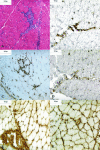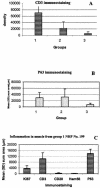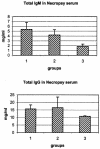Infection and inflammation in skeletal muscle from nonhuman primates infected with different genospecies of the Lyme disease spirochete Borrelia burgdorferi
- PMID: 14638799
- PMCID: PMC308929
- DOI: 10.1128/IAI.71.12.7087-7098.2003
Infection and inflammation in skeletal muscle from nonhuman primates infected with different genospecies of the Lyme disease spirochete Borrelia burgdorferi
Abstract
Lyme borreliosis is a multisystemic disease caused by various genospecies of the spirochete Borrelia burgdorferi. To investigate muscle involvement in the nonhuman primate (NHP) model of Lyme disease, 16 adult Macaca mulatta animals inoculated with strain N40 of B. burgdorferi sensu strictu by syringe or by tick bite or with strain Pbi of B. burgdorferi genospecies garinii by syringe were studied. Animals were necropsied while immunosuppressed on day 50 (two animals each inoculated with B. burgdorferi N40 by syringe and with B. garinii Pbi by syringe) or on day 90, 40 days after immunosuppression had been discontinued (four animals each inoculated with strain N40 by syringe, with strain N40 by tick bite, and with strain Pbi by syringe). Skeletal muscles removed at necropsy were studied by (i) microscopic examination of hematoxylin-eosin-stained sections for inflammation and tissue injury; (ii) immunohistochemical and digital image analyses for antibody and complement deposition and cellular inflammation; (iii) Western blot densitometry for the presence of antibodies; and (iv) reverse transcription-PCR for measurement of the spirochetal load or C1q (the first component of the complement cascade) synthesis. The results showed that N40 was more infectious for NHPs than Pbi. NHPs inoculated with N40 but not with Pbi developed myositis. The inflammation in skeletal muscle was more severe in NHPs inoculated with N40 by syringe than in those inoculated by tick bite. The predominant cells in the inflammatory infiltrate were T cells and plasma cells. The deposition of antibody and complement in inflamed muscles from N40-inoculated NHPs was significantly higher than that in Pbi-inoculated NHPs. The spirochetal load was very high in the two N40-inoculated NHPs examined while they were immunosuppressed but decreased to minimal levels in the NHPs when immunocompetence was restored. We conclude that myositis can be a prominent feature of Lyme borreliosis depending on the infecting organism and host immune status.
Figures








References
-
- Atlas, E., S. N. Novak, P. H. Duray, and A. C. Steere. 1988. Lyme myositis: muscle invasion by Borrelia burgdorferi. Ann. Intern. Med. 109:245-246. - PubMed
-
- Barbour, A. G., and M. E. Schrumpf. 1986. Polymorphisms of major surface proteins of Borrelia burgdorferi.Zentbl. Bakteriol. Mikrobiol. Hyg. Ser. A 263:83-91. - PubMed
-
- Barthold, S., K. Moody, G. Terwilliger, P. Duray, R. Jacoby, and A. Steere.1988. . Experimental Lyme arthritis in rats infected with Borrelia burgdorferi. J. Infect. Dis. 157:842-846. - PubMed
Publication types
MeSH terms
Substances
Grants and funding
LinkOut - more resources
Full Text Sources
Other Literature Sources
Medical

